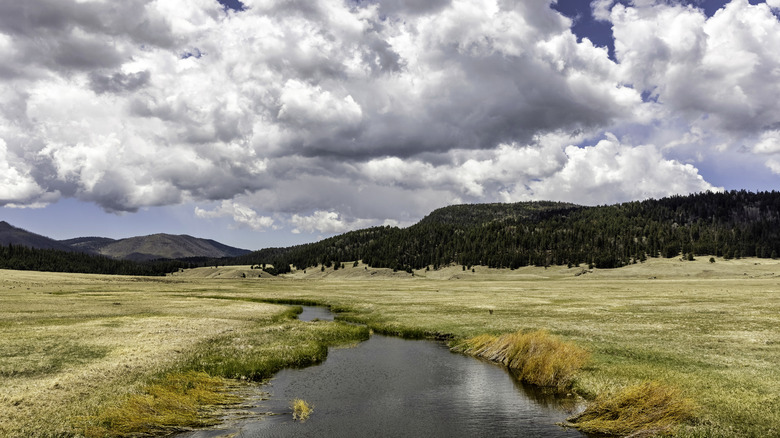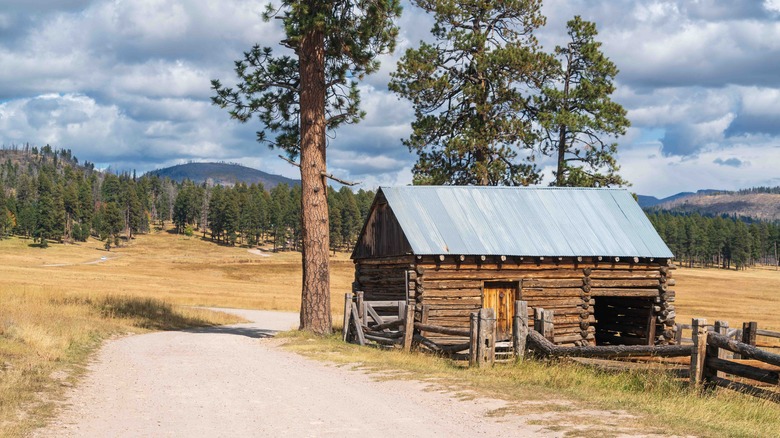An Underrated New Mexico Park Situated On A Dormant Super Volcano Is Filled With Pristine Views
Much of America's diverse and epic landscape comes courtesy of volcanic activity. Many of the most iconic natural wonders in the United States, particularly on the West Coast, were formed from volcanic eruptions along the much larger Pacific Ring of Fire (a massive "ring" of geologically active zones encircling the Pacific Ocean). World-famous spots like Yellowstone, Mount Rainier, and the Hawaii Volcanoes all arose from volcanic activity, and there are several unforgettable active volcanoes in the United States today. Even seemingly peaceful regions may have some explosive volcanic secrets lurking in their geological histories. One perfect example is New Mexico's deceptively pristine and scenic Valles Caldera National Preserve.
Right away, the word "caldera" in its name should clue you in that this beautiful stretch of New Mexico wilderness wasn't always as serene as it is today. Located about two hours north of Albuquerque, Valles Caldera is now a gorgeous stretch of meadows, woodlands, and mountain ecosystems that seem like a lush alternative to the rest of New Mexico's predominantly desert landscapes. However, while Valles Caldera today is one of New Mexico's most blissful nature preserves, its placid exterior masks the remnants of a massive volcano. With picturesque views originating from violent geological upheavals, Valles Caldera National Preserve is one of the best places to explore the complex beauty of America's volcanic heritage.
Valles Caldera is a breathtaking New Mexico landscape forged by fire
Though it's not as well-known for volcanoes as states like Hawaii or Washington, New Mexico actually has one of the largest clusters of uneroded volcanic formations in the United States. Many of these volcanic formations are part of New Mexico's Jemez Volcanic Field. The Valles Caldera is not only the largest formation in the Jemez Field, but is also classified as a veritable "supervolcano," similar to the fearsome hot spot lurking under Yellowstone. Fortunately for us today, the Valles Caldera supervolcano is considered "dormant," so you can explore the park's amazing scenery without worrying about getting caught in the crosshairs of a catastrophic eruption. What remains of the once-formidable supervolcano is a large volcanic crater known as a "caldera" (hence the name "Valles Caldera"). Volcanic calderas are responsible for many of America's top national park sites. In addition to Yellowstone, well-known parks like Oregon's Crater Lake (the deepest lake in the United States) arose in a volcanic caldera.
The Valles Caldera occupies an impressively large area, commensurate with the size of the supervolcano that formed it. The main crater reaches a diameter of 12 to 15 miles across, with walls reaching heights of around 2,000 feet. The caldera's unique topography, rich soil, and higher precipitation have created a complex web of rich ecosystems adorning its stark volcanic domes. This includes ecosystems as diverse as grasslands, montane woodlands, and riparian wetlands. Yet the park does retain some elements of its volcanic origins, including hot springs and fumaroles (i.e., volcanic gas vents). Add the striking geological remnants of ancient volcanic eruptions, and you get one of the most unique landscapes in the National Park System.
Despite its explosive past, Valles Caldera is now a top spot for outdoor recreation
Valles Caldera's distinctive volcanic landscape obviously makes for prime nature photography and sightseeing, but the park also has numerous historical sites to visit. Before it became a national preserve, Valles Caldera was privately owned land primarily used for ranching and logging. Today, the park still has several historic cabins and buildings used by authentic Old West cowboys. And with such an abundance of spectacular scenery spread out across large, flat expanses, Valles Caldera is also a prime spot for scenic hiking. Valles Caldera trails cover all of the park's distinct ecosystems and range from easy hikes over flat terrain to challenging climbs up volcanic formations.
The park is also a terrific destination for biking, horseback riding, and wildlife photography (with resident species like elk, coyotes, and black bears being particular favorites for photographers). Certain areas of the park allow fishing, or elk and turkey hunting. In colder months, Valles Caldera is a top spot for cross-country skiing. And when night falls, the park's lack of light pollution offers unparalleled opportunities for dark sky stargazing. Authorized commercial guides also offer exciting tours or hunting and fishing trips through the park.
Entry to Valles Caldera National Preserve costs $15 per person, or $25 per private vehicle. The park's main entrance is open to vehicles between 9 a.m. and 5 p.m. (or 8 a.m. to 6 p.m. during the summer). Valles Caldera does not currently offer overnight stays, though neighboring parks like Bandelier National Monument and Santa Fe National Forest do have available campsites. Plus, the nearby Los Alamos County has plenty of cozy lodging options, including the "happiest city in America" at the historic and friendly New Mexico community of White Rock.


